As the population of the earth continues to grow, the amount of food we need to produce to survive does at the same time, and then some. Millions of acres of land worldwide are planted in crops, from corn, wheat, and rice, to coconuts, oil palms, and avocados, there are crops growing everywhere. Of course, this is a good thing, how else would all of us be able to eat? However, the untold story is that there are also billions of tons of leftover biomass waste from nearly every crop planted. The seeds from avocados, cherries, and olives to the husks from rice, corn, and wheat, all of that waste needs to be handled in some way. In the past, much of it was hauled to the landfills but they are now clogged to overflowing with household waste. Agricultural waste can be measured in thousands of tons from just one farm in just one year and there isn’t enough room in the landfills any longer. However, now there are biomass carbonization machines that promise to be able to handle the load and recycle all of the agricultural waste we have. Here’s how they work.

Billion Metric Tons Of Waste Biomass Is Created Yearly
Using the right procedures, it’s possible to turn all of that waste into useful energy that can be used in place of fossil fuels. Since agricultural waste is a renewable resource, it doesn’t impact the planet in the same way that fossil fuels that have been buried for millions of years do. In addition to that, when biomass rots, it creates methane, which is a much stronger global warming contributor than carbon dioxide.
Using multiple waste biomass carbonization plants situated near the supply of agricultural biomass can considerably cut down on the transportation costs of hauling waste products. This is especially important with large crops, such as rice, coconut shells, sawdust, or olive seeds since the waste is concentrated at the production plant rather than in the fields. When it comes to other wastes that have to be hauled from the fields there are typically more costs. Here is a video from Beston Machinery, showing the oil sludge treatment process.
In the end, a suitable biomass pyrolysis plant can reduce all of the agricultural waste from a huge production plant into useable and sellable charcoal briquettes. These briquettes can be used in many countries as fuel for cooking stoves, thus saving the nearby forests from constant deforestation and provide a cleaner fuel that emits fewer pollutants due to the higher purity of the charcoal. In many cases, the briquettes are far cheaper than the cost of “homemade” briquettes that are made by hand and cut from the local forests. More information can be found: http://mswrecyclingplant.com/biomass-pyrolysis-plant/.
There are even wood stoves that are made specifically to run on these briquettes that can be used to heat homes, businesses, barns, and factories in order to make use of the inexpensive fuel source.
The use of carbonization plants, no matter sludge carbonization plant or wood carbonization plant, is becoming more common each day as the news gets out about the money to be saved versus hauling the waste to the landfill. Local residents near a plant can benefit from the cheap fuel source and cut back on electricity or propane use during cooking. In all respects, the carbon plants are a win-win for the earth, humans, and farmers at once.
